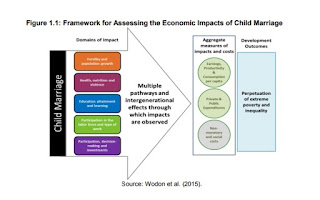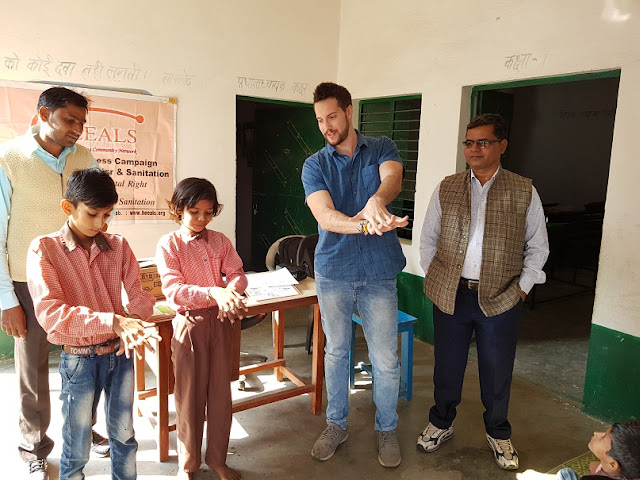AN ECONOMIC SOLUTION TO CHILD MARRIAGE?
According to
UNICEF, every years about 700 millionof child girls get married in the whole
world.
Specialists claim
that the end of child marriage practice could add more than $4tn to the global
economy, curb population growth and transform the lives of millions of young
women worldwide.
Particularly, a
recent study by the World Bank(WB) and
the International Center for Research on
Women (ICRW), the first to quantify the financial cost of that phenomenon,
suggests that eradicating child marriage would save governments money while
enabling girls to complete their education and get better jo“this
research provides crucial evidence showing that child marriage does not just
impact the lives of the 700 million girls married every year, but also has a
major negative impact on the economic development of the countries in which
these girls live”.

A closer look to
Indian currently situation reveals that, in the Country, more than 26 million
women became brides before 18. One of the several reason is that, here, marriage
tend to be very expensive for the bride’s family and it is a common
understanding that more the girl is young more the expense for the marriage fall
down, especially because in communities where the bride’s family pays the
groom a dowry, they often have to pay less money if the bride is young and
uneducated.Moreover,pooer
families not only can not afford a good level of instruction for their children
but also they strongly believe that it is better for them working instead of
studying. Likewise, often those families must sell their children into marriage
either to settle debts or to make some money. It is a cruel but, at the same
time, real fact that giving a daughter in marriage allows parents to reduce
family expenses by ensuring they have one less person to feed, clothes and
education.
Governments and other
policymakers should be spurred on by these data to commit additional energy and
resources to ending child marriage as soon as possible. Doing that, it is
possible to alleviate endemic poverty and to ensure that girls,everywhere, have access
to a brighter future. At the same time, it is also true that defeating child
marriage it is a paramount step for cutting institutional expenses and for
increasing the national economy.
As a matter of fact,
child marriage practice deeply annoy the Indian public system, increasing the
sanitary system’s spending, the level of poverty, that one of population and,
simultaneously, reducing human capabilities. These benefits would be felt
particularly strongly in poorer segments of populations, since young girls in
poverty are more likely to marry early than girls from other socio-economic
groups.
Under this perspective,
India Government has launched a few “Girls’ Development Projects”. Among those,
the most remarkable, from the economic point of view, is the SUKANYA SAMRIDDHI YOJANA ACCOUNT, which
has been promoted from January 2015, under
the ‘Beti Bachao Beti Padhao’ initiative.
For fully understanding
how that Programme works, it is necessary considering his 10 main features,
explained in the apposite guide, provided by India Government.
1.
A guardian can
open only one account in the name of one girl child and a maximum two accounts
in the name of two different girl children.
2.
A Sukanya
Samriddhi account can be opened in the name of a girl child till she attains
the age of 10 years.
3.
Sukanya
Samriddhi accounts can be opened in post offices and in designated public
banks.
4.
Deposits can be
made up to 14 years from the date of opening of the account.
5.
After this
period, the account will only earn interest according to applicable rates.
6.
The account can
be closed after completion of 21 years.
7.
Deposits made
into the Sukanya Samriddhi account, the interest earned, and the maturity
amount are tax-free.
8.
The minimum
deposit that needs to be made every year into Sukanya Samriddhi account is now
Rs 250.
9.
The maximum
amount that can be deposited into Sukanya Samriddhi account on a yearly basis
is Rs 1.50 lakh.
10. Partial withdrawal
from a Sukanya Samriddhi account, up to 50% of the balance at the end of the
preceding financial year, can be made after the account-holder attains the age
of 18, according to the India Post website.
The principal
purposes of the Sukanya Samriddhi accountare:
·
Ensuring
financial security of a girl child when she comes adult.
·
Making sure the
education of the girl child continues uninterrupted.
·
Making sure
that the girl is not married off before she becomes an adult (18 years old).
All of them have been
thought to cope with the problem of child marriage in India.
According to BussinessToday, till November 2017, more
than 1.26 crore accounts were opened across the country securing an amount of
Rs 19,183 crore.
Although this noble
initiative, the rate of child marriagge in India is one of the higest so far.
It seems that parents, who maybe open that account for their daughters, decide
to use that money for celebrating a good marriage instead of affording a good
level of education.
To sum up,nowadays child marriagge practice is too spread in India, so
it is not possible solve it with a simple and singular economic proposal.
Having said that, in my opinion only an integrate strategy, which include both
economic and social aspect, could have concrete result in the long time.
Martina Scavino
WASH & Intern coordinator



































